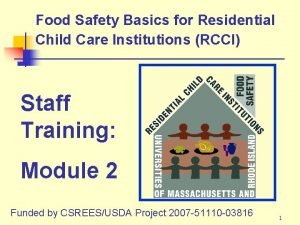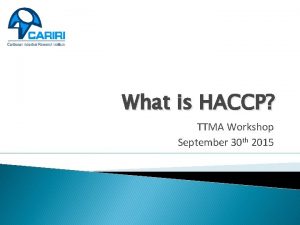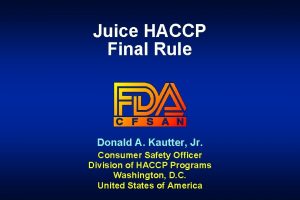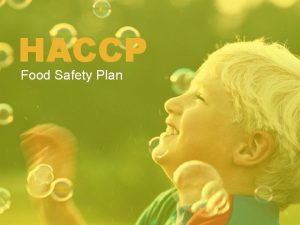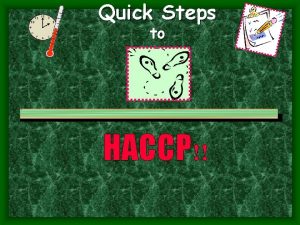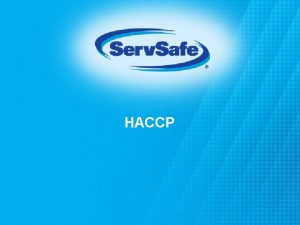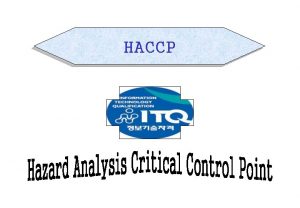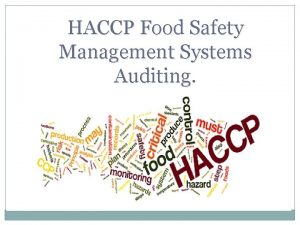HACCP Food Safety Plan What is HACCP n










- Slides: 10

HACCP Food Safety Plan

What is HACCP? n n HACCP (Hazard Analysis Critical Control Point) is a systematic way to identify, evaluate, and control food safety hazards. Hazards are biological, chemical, or physical agents likely to cause illness or injury if they are not controlled. HACCP prevents food safety hazards rather than reacts to food safety hazards. To develop a HACCP plan, one follows the seven principles. C-6. 02 -- HACCP

Prerequisite Programs Focus on employees, facilities, and equipment. Examples of prerequisite programs include: n n n Illness policy Cleaning and sanitizing procedures Garbage removal Pest control Equipment selection Employee hygiene C-6. 02 -- HACCP

1: Conduct a hazard analysis n Identify hazards associated with a specific menu item. n n n Prepare flow diagram from receiving to service. List likely hazards associated with each step. Identify how to prevent the hazards at each step. Hazards can be biological, chemical, or physical. List hazards likely to occur and that will cause severe consequences if not controlled. Hazards that are low risk and that are not likely do not need to be considered. C-6. 02 -- HACCP

2: Determine CCPs n n n A control point is any point, step, or procedure where biological, physical, or chemical factors can be controlled. A critical control point (CCP) is a point, step, or procedure where an identified hazard can be prevented, eliminated, or reduced to acceptable levels. Critical control points are monitored much more frequently than are control points. C-6. 02 -- HACCP

3: Establish critical limits n n Establish criteria that must be met to prevent, eliminate, or the reduce the identified hazard at the CCP so that the food is safe to eat. Examples of critical limits are: n n temperature, time, physical dimensions, water activity, p. H, and available chlorine Critical limits can come from regulatory standards and guidelines, scientific literature, experimental studies, and consultation with experts. C-6. 02 -- HACCP

4: Establish monitoring procedures n Monitoring is a planned observation or measurement: n n to determine if a CCP is under control and Examples of monitoring include: n n n Visual observations Temperature measurements Time assessment p. H measurements Water activity measurements C-6. 02 -- HACCP

5: Establish corrective actions n Corrective actions focus on: n n Example of a corrective action: n n n what do when a food does not meet the critical limit. A hamburger is 140 o. F (50 o. C) Critical limit -- Cook hamburger to 155 o. F (68 o. C) or hotter. Continue cooking until hamburger is 155 o. F (68 o. C) or hotter. Throwing out food might be a corrective action. Maintain records of all corrective actions taken. C-6. 02 -- HACCP

6: Verification procedures Four phases needed for a HACCP plan: 1. Determine that critical limits for all CCPS are sound. 2. Make sure that the establishment’s HACCP plan is being properly implemented. 3. Have regulatory personnel review the plan to make sure that it is being properly implemented. 4. Check the accuracy of all monitoring equipment. C-6. 02 -- HACCP

7: Establish record keeping The following make up the records of a HACCP Plan – – – – – List of HACCP team and their assigned responsibilities Description of each menu item Flow diagram for each menu item indicating CCPs Hazards associated with each CCP and preventive measures Critical limits Monitoring procedures Corrective actions plans Record keeping procedures Procedures for verification of the HACCP plan C-6. 02 -- HACCP



